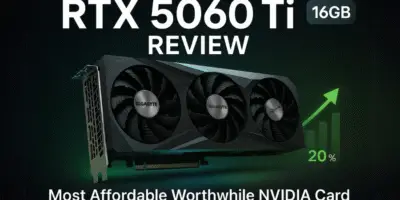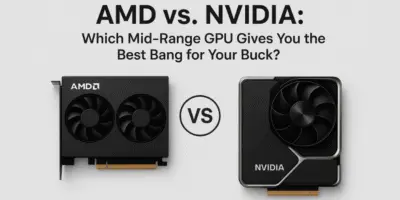After a full month of rigorous testing with the RTX 5090 Founders Edition, I’ve pushed this beast to its limits. I’ve tested it with various processors, multiple monitors, tried undervolting, and even ran my entire Steam library on it! This is probably the most comprehensive review you’ll find on this graphics card, covering absolutely everything you need to know.
Table of Contents
Testing My Entire Steam Library
This might sound like a crazy idea (and yes, sometimes it is), but testing a wide range of games gives us a deeper understanding of the card’s architecture and helps identify any potential issues. I have over 200 games in my Steam library, though only about 50 are installed on my PC. Don’t worry—I won’t be testing all 200 games, or this article would turn into a novel!
Here’s the test system specs I used:
- Graphics Card: NVIDIA RTX 5090 Founders Edition
- CPU: Intel Core i9-14900K / AMD Ryzen 9 9800X3D (plus additional testing with other CPUs)
- RAM: 64GB DDR5
- Storage: PCIe 4.0 NVMe SSD
Old & Classic Games
Let’s start with some classics! Testing older games on high-end hardware is like putting a feather on a battleship to see if it can handle the weight—of course it can! But it’s interesting to see how these games perform.
Half-Life 2 – This masterpiece still holds up after all these years. With the 5090, I was getting around 400fps at 4K. The beauty of Source engine games is how well they scale with modern hardware while maintaining that perfect responsiveness feeling.
Age of Empires 2 HD – The game ran at thousands of frames per second—so many that it actually got stuck on the loading screen until I limited it to 1000fps! This is what happens when you try to run older game engines on hardware they were never designed for. Playing at higher resolutions actually hurts the experience here, as the UI elements become too small.
Counter-Strike (Original) – While I couldn’t get a proper fps reading in monitoring software, FRAPS showed it was running at an absurd framerate. The card’s fans weren’t even spinning. Classic “runs on a potato” territory!
Max Payne – This 21-year-old game still looks revolutionary for its time. The physics, gameplay, and graphics were groundbreaking, and they hold up surprisingly well. It ran at incredible framerates on the 5090.
San Andreas – One of the worst PC ports when it released 17 years ago, and it still has issues today. While it ran at max settings, the framerate was never stable—poor optimization at work. Note that you can’t buy this original version anymore; Rockstar forces you to get the remastered version, which many PC players consider inferior.
Modern AAA Titles
Cyberpunk 2077 – With RT Ultra settings and DLSS Quality at 4K, the game maintained high refresh rates. This kind of performance was unthinkable even a year ago. Path tracing (Overdrive mode) is still extremely demanding, delivering around 35fps at 4K—basically ray tracing multiplied by 3-4x intensity. Nobody buys a 5090 to play at 30fps though, so with standard RT features and DLSS, you’ll get a smooth high-refresh experience.
Alan Wake 2 – The experience was phenomenal even at max settings with ray tracing. The ATAK engine is extraordinary at utilizing hardware resources.
Dying Light 2 – Ray tracing makes a massive difference in this game’s visuals, though it’s demanding. The game is capped at 60fps, but it maintained that target almost perfectly at 4K with all settings maxed out.
Starfield – Despite being relatively new, it ran at 4K high refresh rates with no issues. If this is your first Bethesda game, you might enjoy it, but compared to Fallout 4, it feels somewhat shallow in content.
Ghost of Tsushima – The lighting and textures here are incredible. This is a high texture, ray-traced lighting showcase that makes other games look primitive by comparison. With DLSS, the 5090 delivered exceptional 4K high refresh rate performance.
Call of Duty: Modern Warfare III – This game has had performance issues for months that Activision hasn’t fixed. There’s about a 35% performance hit just because of voice chat settings! Disabling voice chat or setting it to “friends only” dramatically improved performance.
Red Dead Redemption 2 – This five-year-old game is still one of the most demanding titles on PC. At native 4K ultra settings, I was getting around 200fps—something only the 4090 and 5090 can achieve above 60fps at native 4K.
DOOM Eternal – The id Tech engine shows its optimization prowess here. With RT enabled and max settings at 4K, the framerates were through the roof, and the experience was buttery smooth.
Stalker 2 – Extremely demanding on all hardware components—CPU, RAM, VRAM, and graphics card. With DLSS and FSR, we achieved excellent high refresh rates at 4K.
Forza Horizon 5 – One of my testing staples because it received a next-gen update that significantly improved graphics while making it much more demanding. With RT Ultra at 4K native resolution, only the 5090 can deliver above 60fps.
What CPU Do You Need for the RTX 5090?
Since this card is clearly aimed at 4K gaming (and can deliver high refresh rates at that resolution), what processor do you need to avoid bottlenecks?
I tested several processors ranging from budget to high-end options:
- Intel Core i3-14100F
- AMD Ryzen 5 7600
- Intel Core i9-14900K
- AMD Ryzen 9 9800X3D
The results were fascinating:
The Witcher 3 (Next Gen)
With RT Ultra and DLSS Quality, almost all processors were sufficient. Even the i3 delivered nearly the same performance as the i9 and Ryzen 7.
But don’t rush to conclude that a budget CPU is enough for all games! The Witcher 3 is uniquely less demanding on the processor. Other games tell a different story:
Cyberpunk 2077
With RT enabled, there were immediate differences between budget and high-end CPUs. The Ryzen 5 7600 was barely adequate, but to fully utilize this card, you really need the 9800X3D. Even the i9 was slightly insufficient.
Dying Light 2
Similar story here—even the i9 wasn’t quite enough. The 9800X3D was needed to prevent bottlenecks.
Ghost of Tsushima
Every processor created a bottleneck in this game—even the 9800X3D! How can you benefit from this bottleneck? You could enable Frame Generation, which utilizes the GPU without CPU involvement. Alternatively, wait for even more powerful processors to fully leverage this card’s capabilities.
Last of Us Part 1
This was the only game where the i9-14900K outperformed the 9800X3D—a truly unusual case.
Stalker 2
Very demanding on all components. With this card, only the 9800X3D could extract maximum performance.
Call of Duty
After disabling voice chat (which caused optimization issues), the i3 performed decently at around 110fps, but again, you need the 9800X3D to get the absolute most from this GPU. Even the i9 wasn’t quite enough.
The pattern is clear: if you’re buying a card this powerful, you’ll want to pair it with the most powerful gaming CPU available—currently the Ryzen 9 9800X3D—to avoid bottlenecks and truly leverage its capabilities.
Temperatures, Power Consumption, and Undervolting
I’ve received numerous requests to make an undervolting guide for 5000-series cards, especially the 5090. Here’s what I found:
After a 10-minute stress test, the core temperature reached 74°C—slightly higher than third-party versions. ASUS TUF models averaged in the mid-60s, and the Gigabyte Gaming OC around 69°C. Of course, those third-party cards are physically larger.
The Founders Edition is impressive considering its relatively compact size (it fits in standard ATX cases) yet can dissipate 575W! Yes, that’s the power consumption under load—575W from this relatively small card is remarkable.
The build quality is exceptional—it’s constructed entirely of metal with premium materials throughout. Under load, the core clock stabilized at around 2625MHz, though this can vary slightly depending on the game, sometimes reaching an average of 2700MHz.
How to Undervolt the RTX 5090
This method works for all 5000-series cards:
- You’ll need three programs: GPU-Z, MSI Kombustor, and MSI Afterburner
- Open GPU-Z and go to the Sensors tab
- Scroll down to monitor GPU voltage
- Run a stress test in MSI Afterburner for about 10 minutes
- Note three key metrics: GPU clock speed (around 2600MHz), power consumption (575W), and voltage (1035mV)
To undervolt:
- Press Ctrl+F in MSI Afterburner to open the voltage/frequency curve
- The ideal voltage range for 5000-series cards is between 850-900mV with clock speeds between 2600-2800MHz
- For example, to undervolt to 900mV:
- Click on the 900mV point
- Hold Shift and drag it up to around 2700MHz
- Hold Shift again and select all points to the right of this point
- Drag them down below your set point
- Apply settings and run another stress test
In my testing, power consumption dropped to around 450W with minimal performance impact. The 5000-series cards, especially the 5090, undervolt exceptionally well.
After finding stable settings, save them as a profile in MSI Afterburner and enable automatic startup so they apply every time you boot your PC.
Conclusion: Is the RTX 5090 Founders Edition Worth It?
Pros:
- Astounding performance—so powerful that in some games at 4K, it creates CPU bottlenecks even with the most powerful processors
- 32GB VRAM—currently overkill for most games, but beneficial for 3D applications and AI workloads
- The Founders Edition specifically has impressive cooling and a compact design that can dissipate 575W in a relatively small form factor
- Premium build quality—all-metal construction gives it a truly premium feel
- Excellent technologies like DLSS, Frame Generation, and powerful encoding/decoding capabilities (three encoders/decoders of all types for content creation)
Cons:
- High price with questionable value compared to previous generations, especially the RTX 4090. It’s about 30% more powerful but doesn’t offer the same value proposition
- Very high power consumption (though undervolting helps significantly)
- Some driver issues, particularly with capture cards—surprisingly, this is the first time I’ve experienced such issues with NVIDIA cards (previously more common with AMD)
Recommendation:
Despite being impressive in every way, I can’t recommend purchasing the RTX 5090 solely for gaming—it’s not good value for that purpose alone. However, if you have specific use cases that can leverage its enormous memory, like AI workloads or 3D applications that might generate income, then it becomes an exceptional card for content creation, AI, and gaming combined.
For pure gaming, it’s overkill—serious overkill!


